Today, we are going to test a new stylish touchscreen smartphone that uses the Symbian operating system (S60 series 5th Edition): the Sony Ericsson Vivaz.
The package box is colorful but not compact (Pic. 1). If you take the box upside-down, the accessories are likely to fall out.
The retail package is standard issue stuff. In addition, there is an 8GB card and a TV out cable (Pic. 2). The Vivaz comes with the stylus which dangles by a thread from the bottom of the phone.
The body of the Sony Ericsson Vivaz is almost entirely made of plastic with a gloss effect (Pic. 3, 4). Besides, the phone boasts a resistive touchscreen display. All these features make the Vivaz unreliable in use. Read further to know the results of the stress tests.
Results
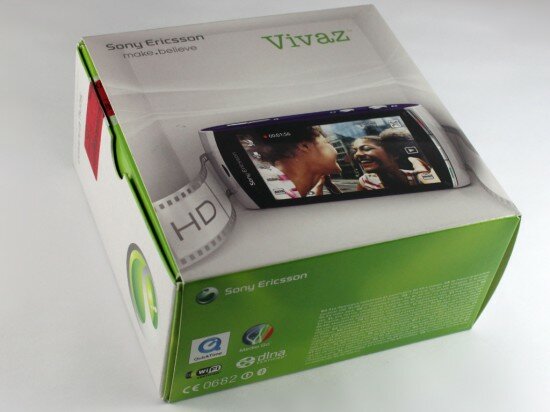
Pic. 1. Package box

Pic. 2. Accessories
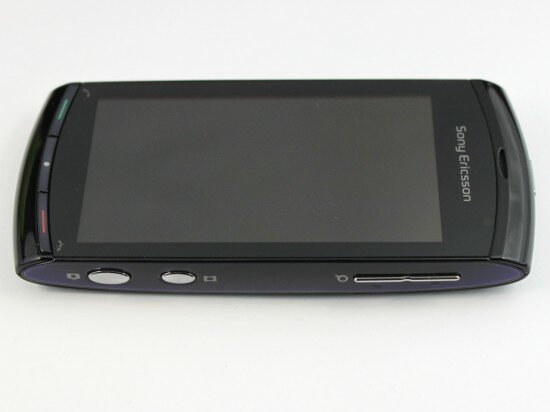
Pic. 3. Sony Ericsson Vivaz (front panel)
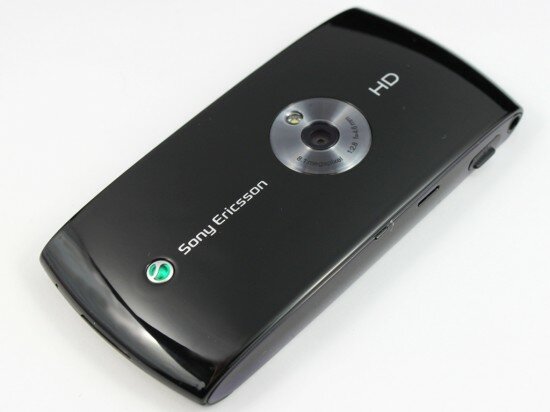
Pic. 4. Sony Ericsson Vivaz (back panel)
1. Sony Ericsson Vivaz stress tests. Stage 1 — Light shocks
1.1 Drop test
First of all, we found out how the Sony Ericsson Vivaz would stand up to the knocks and bumps. Anyone can easily flick his/her cell phone off the table or drop it on a floor.
We successively dropped the Vivaz on the carpet (video 1) from 1 m (3.28 ft) and on the tile (video 2) from 30 cm (11.8 inches).
The back cover stayed non-removable during the drops. The phone sustained no damage at all. In general, the result of the drops from small distances is fine.
Video 1. Drops on the carpet from 1 m (3.28 ft)
The grade is 30 (with 30 being the highest possible grade)
Video 2. Drops on the tile from 30 cm (11.8 inches)
The grade is 30 (with 30 being the highest possible grade)
1.2 Squeeze test
We placed the phone on a table and applied a 3 kg (6.6 lbs) pressure from a wooden bar above it. This weight is too little to inflict any visible damage.
The back panel has a protuberant shape and all the pressure was applied at the camera compartment. Nevertheless, the gadget sustained no damage (Pic. 5).
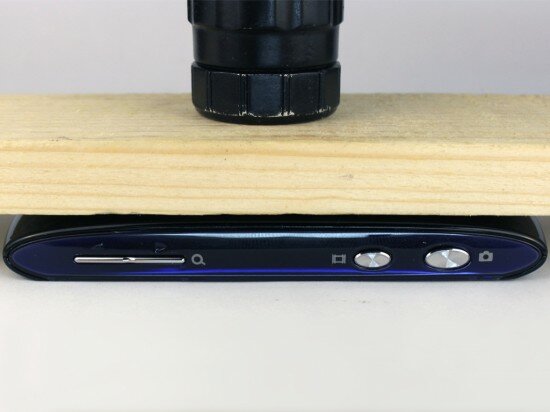
Pic. 5. The phone under the wooden bar
The grade is 24 (with 24 being the highest possible grade)
1.3 Bend test
We performed one more test to find out how the handset would fare after the physical attacks. We put the Sony Ericsson Vivaz onto the two planks so that each edge of the phone lies on a single plank. Then we hitched a string with 1 kg load (2.2 lbs) on top of the device. The gadget showed no sign of bend and stayed functional.
The grade is 24 (with 24 being the highest possible grade)
1.4 Durability
Before buying a cell phone, you probably wondered how it would look like after a long period of everyday use. We hope that the test in a drum can give us the answer. Actually, we placed the Vivaz inside the drum together with keys, pennies, and plastic balls to simulate what might be happening in a man’s pants pockets while carrying the phone. The drum was rotated for 5 minutes at the speed of 500 rpm (video 3).
To tell you the truth, we didn’t expect such a good result. We saw the scuffs on the edges (Pic. 6) but the sides of the phone stayed almost as new (Pic. 7). The glossy back cover sustained damage only on the corners. When we looked at the back panel, we saw our images like in the mirror. The resistive display showed a little damage (perhaps, more than a little) (Pic. 8).
Video 3. Drum rotation

Pic. 6. Scuffs on the edges of the phone

Pic. 7. No evidence of damage on the sides of the phone
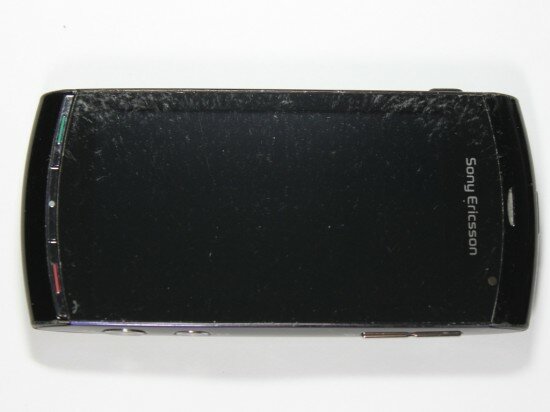
Pic. 8. Scuffs on the screen
The grade is 15 (with 15 being the highest possible grade)
1.5 Scratch test
If a cell phone is claimed to be ruggedized, it doesn’t mean that it is scratch resistant. A mobile phone can look as new after a long period of carrying in a pocket but it may show much damage if you scratch it accidentally.
In order to test the material of which the Sony Ericsson Vivaz is made, we scratched it with a nail fixed in a plank (video 4). The force of scratches was 100 g (0.22 lbs). Neither the screen nor the back panel showed any scratch.
Video 4. Back panel scratching
The screen gets 15 points (with 15 being the highest possible grade)
1.6 High temperature test
In this test, we found out what would happen to the Vivaz if we left it in the sun on a hot summer day. Actually, we simulated this situation by doing the following: we placed the gadget in a metallic container 5 cm from the electric bulb (40 Wt). The bulb heated the device for 3 min. (video 5). As a result, the temperature of the phone rose to 60 °C (140 °F). But the handset didn’t show any sign of melting and stayed absolutely functional.
Video 5. High temperature test
The grade is 12 (with 12 being the highest possible grade)
1.7 Dust test
During the period of everyday use, dust penetrates and accumulates in electronic gadgets. Grains of dust spoil not only the look of a cell phone but also its display quality. We can’t wait until dust penetrates the Sony Ericsson Vivaz. So we took an enclosed tray containing dust and threw the phone inside it. We made it vibrate viciously for 2 minutes in order to check dust resistance of the device.
After the test, we examined the gadget (Pic. 9) and saw a few grains of dust when we removed the battery cover (Pic. 10). Some dirt penetrated the phone through the small gaps around the camera compartment. The USB port stayed almost clean – the plastic lid did its job well (Pic. 11). The keys worked without squeaks. After the test, we cleaned the phone and it performed perfectly.

Pic. 9. Here’s how the phone looks like after this test
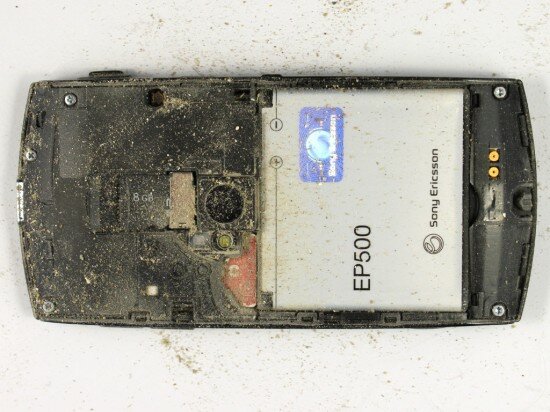
Pic. 10. Dust under the back cover
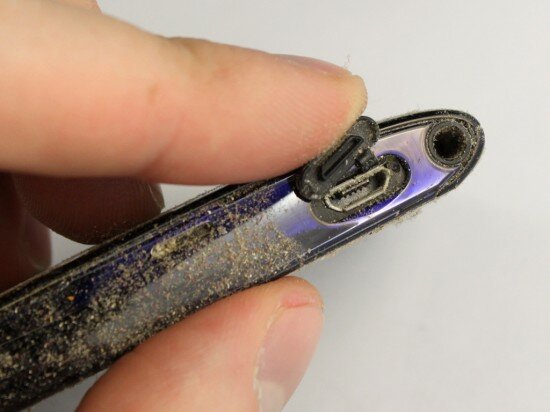
Pic. 11. Dust in the USB port
The grade is 12 (with 12 being the highest possible grade)
1.8 Signal strength test
We always remember that the main function of any cell phone is to make and receive calls. A handset has a strong signal if it can receive calls from the areas where a reception is poor. In order to test the signal strength of the Sony Ericsson Vivaz, we placed it inside a box. Then we foiled the box (the foil served as a shield) and made a 40 x 50 mm (1.57 x 1.97 inches) hole in it (video 6).
The signal indicator displayed 3-4 bars from the maximum possible signal strength of 5. However, the phone successfully received all of the 10 incoming calls.
Video 6. Signal strength test
The grade is 15 (with 15 being the highest possible grade)
After the 1st stage of the stress tests, the Sony Ericsson Vivaz got 192 (with 192 being the highest possible grade)
2. Sony Ericsson Vivaz stress tests. Stage 2 — Tough conditions
2.1 Drop test
This time, we increased the distance of the falls. We dropped the Sony Ericsson Vivaz from 1.5 m (4.9 ft) on the carpet and from 50 cm (1.64 ft) on the tile (video 7, 8).
During the drops on the carpet, the back cover opened several times but stayed non-removable. The result of the drops on the tile was worse. After the 6th drop (with the face down), the phone rebooted itself and didn’t show stable performance afterwards. The touchscreen malfunctioned all the time (video 9). We didn’t see any visible damage. But it seemed that there were problems with the operating system and not with the display. We tried to make a call but the phone didn’t work. So we had to lower the grade for the Sony Ericsson Vivaz in this test. Moreover, we are not going to take into consideration the results of all the other stress tests because the phone is broken.
Video 7. Drops on the carpet from 1.5 m (4.9 ft)
Video 8. Drops on the tile from 50 cm (1.64 ft)
Video 9. The performance of the phone after the drop test
The grade for the drops on the carpet is 30 (with 30 being the highest possible grade)
The grade for the drops on the tile is 10 (with 30 being the highest possible grade)
2.2 Squeeze test
We made this test tougher. When we applied a 10 kg (22 lbs) pressure from the wooden bar above the Sony Ericsson Vivaz, we heard a squeak. If the phone wasn’t broken, the grade would be 24 (with 24 being the highest possible grade).
Nevertheless, the grade is 0 (with 24 being the highest possible grade)
2.3 Bend test
In the 2nd stage of this test, we increased the weight of the load to 5 kg (11 pounds). As a result, we saw a slight bend (Pic. 12).

Pic. 12. The result of the bend test (the weight of the load is 5 kg (11 pounds))
If the phone wasn’t broken, the grade would be 24 (with 24 being the highest possible grade).
But the grade is 0 (with 24 being the highest possible grade)
2.4 Durability test
The Vivaz showed fine results in the previous stage of the durability test. But now we increased the time of the experiment to 10 min.
As a result, more scuffs appeared on the back panel, especially on the corners of the back panel (Pic. 13). We also saw the scratches on the sides of the phone (Pic. 14). The screen became unattractive. A number of small scuffs and minor scratches ruined the quality of the picture (Pic. 15).
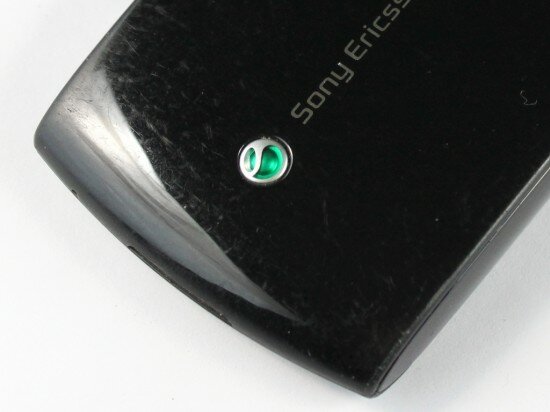
Pic. 13. Scuffs on the back cover

Pic. 14. Here’s how the edges of the phone look like after the test

Pic. 15. Here’s how the screen looks like after the test
If the phone wasn’t broken, the grade would be 10 (with 15 being the highest possible grade).
But the grade is 0 (with 15 being the highest possible grade)
2.5 Scratch test
This time, we increased the force of scratches to 300 g (0.66 lbs) (video 10, 11). After the test, we examined the device. When the backlight was off, the scratch on the screen was invisible. But when it was on, this scratch struck the eye. The damage of the back panel was visible only in the bright lights.
Video 10. Screen scratching (the force of scratches is 300 g (0.66 lbs))
Video 11. Back panel scratching (the force of scratches is 300 g (0.66 lbs))
If the phone wasn’t broken, the grade for the screen would be 10 and the grade for the back panel would be 15 (with 15 being the highest possible grade).
In truth, the screen and the back panel get 0 (with 15 being the highest possible grade)
2.6 Freeze test
It’s not a secret that to use a cell phone in winter is very uncomfortable, especially if you wear gloves and a cap. However, this is not all inconveniences that you and your handset may face in cold weather. The capacity of the battery usually goes down much faster compared to moderate temperatures. In order to check the performance of the Sony Ericsson Vivaz in such environments, we did the following: we took a box filled with ice cubes, placed the gadget in it, and then placed the box in a freezer for 2 hours. The phone was left in speaking mode during that time. The temperature in the freezer was approximately -15 – -20 °C (+5 – -4 °F).
The capacity of the battery didn’t go down much (video 12). The touchscreen malfunctioned a little bit but the sensor stayed fine. The performance of the keys was also all right.
Video 12. Freeze test
If the phone wasn’t broken, the grade would be 18 (with 18 being the highest possible grade).
But the grade is 0 (with 18 being the highest possible grade)
2.7 High temperature test
We increased the time of heating to 5 min. Despite the temperature of the phone rose to 68 °C (154.4 °F), the phone stayed functional (video 13).
Video 13. High temperature test
If the phone wasn’t broken, the grade would be 12 (with 12 being the highest possible grade).
But the grade is 0 (with 12 being the highest possible grade)
2.8 Immersion in water
It’s time we performed a water test. Actually, we dunked the phone under water for 1 second, a rather short period of time (video 14). The water didn’t penetrate the phone and the innards stayed safe. However, we saw the evidence of water when we removed the battery cover. The USB port stayed dry. After the air drying, the Vivaz performed as fine as before the test.
Video 14. Immersion in water for 1 second
If the phone wasn’t broken, the grade would be 30 (with 30 being the highest possible grade).
But the grade is 0 (with 30 being the highest possible grade)
2.9 Dust test
We increased the time of the dust test to 5 min.
After this test, we examined the Sony Ericsson Vivaz. We saw the same amount of dirt under the back cover as in the previous dust test. More dirt penetrated in the USB port, though (Pic. 16). Apparently, some grains of dust seeped in the phone through the loudspeaker gill. As a result, we saw a spot of dirt on the display (Pic. 17). In order to get rid of this spot, we have to replace the display. Some grains of dust penetrated under the loudspeaker membrane and distorted the sound.
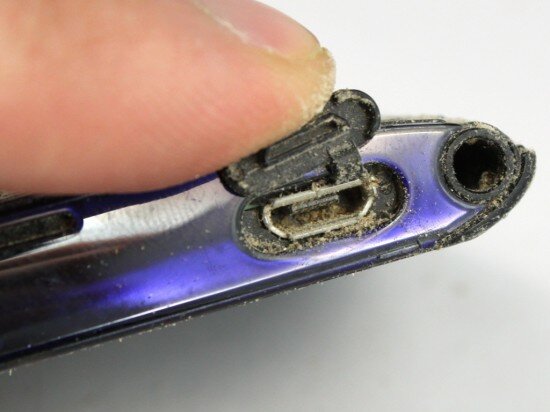
Pic. 16. Dust in the USB port

Pic. 17. The spot of dirt on the screen
If the phone wasn’t broken, the grade would be 10 (with 15 being the highest possible grade).
But the grade is 0 (with 15 being the highest possible grade)
2.10 Signal strength test
We decreased the size of the hole in the shielded box to 20 x 20 mm (0,787 x 0,787 inches). The signal from the tower was reduced considerably (video 15). The signal indicator displayed only 2 bars from the maximum possible signal strength of 5. However, the phone successfully received all of the 10 incoming calls.
The signal strength tests were performed before the stress tests. That’s why we take into consideration the results of this experiment.
Video 15. Signal strength test
The grade is 15 (with 15 being the highest possible grade)
After the 2nd stage of the stress tests, the Sony Ericsson Vivaz got 55 (with 240 being the highest possible grade)
3. Sony Ericsson Vivaz stress tests. Stage 3 — The toughest conditions
3.1 Drop test
In the last stage of the drop tests, we increased the distance of the falls on the carpet to 2 m (6.56 ft) and to 1 m (3.28 ft) on the tile (video 16, 17).
In spite of the fact that the Sony Ericsson Vivaz showed poor results in the previous drop test, we are sure that the back cover of the phone will stay non-removable no matter how you drop it.
There’s an interesting fact: after the 3rd stage of this test, the gadget started to perform pretty fine. It didn’t malfunction any more. We could dial numbers and lock the keys. The phone made calls with no problem. Some people claim that one of the ways to mend the broken electronic gadgets is to knock them. To some extent, it’s true. But how long will these gadgets work after such mending?
We are not going to evaluate the results of the further stress tests.
Video 16. Drop on the carpet from 2 m (6.56 ft)
Video 17. Drop on the tile from 1 m (3.28 ft)
If the phone wasn’t broken, the grade for the drops on the carpet and on the tile would be 30 (with 30 being the highest possible grade).
But the grade is 0 (with 30 being the highest possible grade)
3.2 Squeeze test
This is the toughest stage of the squeeze test. We increased the pressure we applied to 20 kg (44 lbs). When we put the wooden bar on the Vivaz, we heard a squeak, produced by the grains of sand that penetrated the phone during the dust tests. We didn’t expect good results from the gadget in this test. But the handset performed pretty fine afterwards. The camera stayed absolutely functional.
If the phone wasn’t broken, the grade would be 24 (with 24 being the highest possible grade).
But the grade is 0 (with 24 being the highest possible grade)
3.3 Bend test
We applied 10 kg (22 lbs) weight in our 3rd attempt to bend the Sony Ericsson Vivaz. When we put it onto the two planks with its face both down and up, the phone showed the slight bends in both cases.
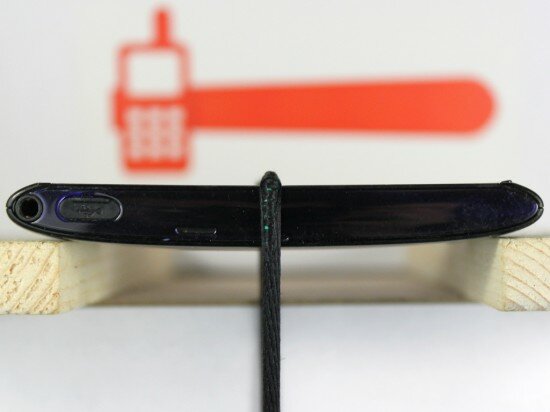
Pic. 18. The result of the bend test (the pressure was 10 kg (22 lbs))
If the phone wasn’t broken, the grade would be 24 (with 24 being the highest possible grade).
But the grade is 0 (with 24 being the highest possible grade)
3.4 Durability
The 1st stage of the durability test lasted 5 min. In the 2nd stage of this test, the drum was rotated for 10 min. But now, we increased the time of this experiment to 20 min.
As a result, the glossy back cover became unattractive, but we can’t say that it was ugly (Pic. 19). We saw the scuffs on the chrome-effect of the volume rocker (Pic. 20) and also many scuffs and scratches on the screen (Pic. 21). Some of them badly ruined the quality of the picture (Pic. 22).
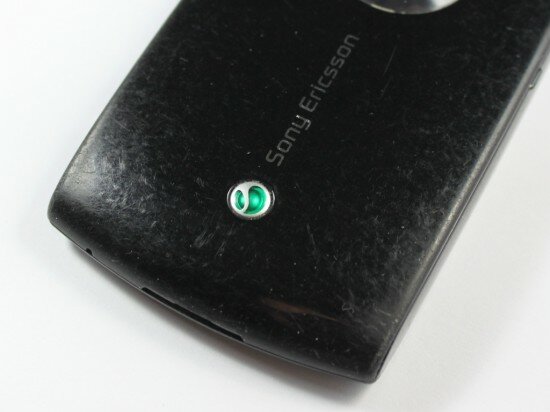
Pic. 19. Here’s how the back panel looked like after the test
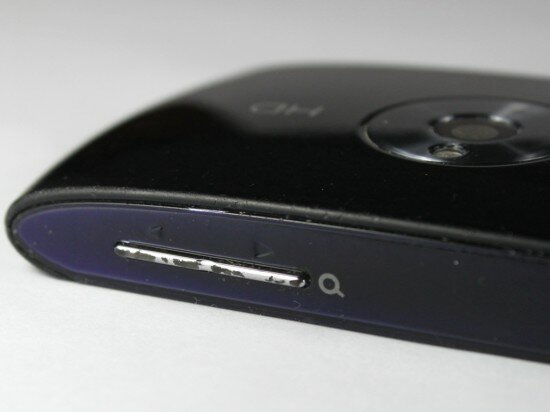
Pic. 20. Scuffs on the chrome-effect of the volume rocker
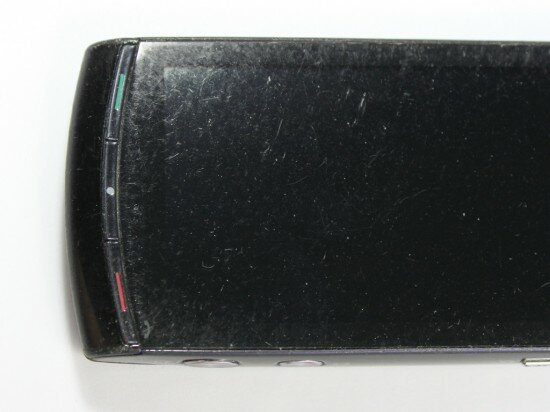
Pic. 21. Here’s how the screen looked like after the test

Pic. 22. This is how the scuffs and scratches ruined the quality of the picture
If the phone wasn’t broken, the grade would be 10 (with 15 being the highest possible grade).
But the grade is 0 (with 15 being the highest possible grade)
3.5 Scratch test
This time, we increased the force of scratches to 600 g (1.322 lbs). Both the screen and the back panel sustained deep scratches (Pic. 23, 24, video 18, 19).
Video 18. Screen scratching
Video 19. Back panel scratching
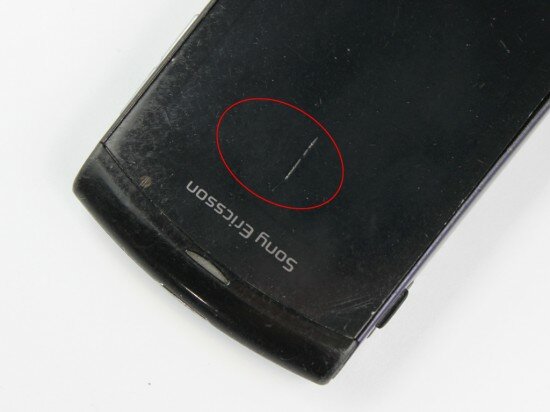
Pic.23. Scratch on the screen

Pic.24. Scratch on the back panel
If the phone wasn’t broken, the grades for both the screen and the back panel would be 10 (with 15 being the highest possible grade).
However, the grade is 0 (with 15 being the highest possible grade)
3.6 High temperature test
We put the handset close to the electric bulb and left it for 10 min. As a result, the display became dim. The temperature of the phone rose to 95 °C (203 °F), more than enough to get burn on the hands (video 20). The touchscreen subsided a little bit. But this was almost invisible. The Vivaz stayed functional. When the temperature became normal, the gadget performed pretty fine.
Video 20. High temperature test
If the phone wasn’t broken, the grade would be 8 (with 12 being the highest possible grade).
But the grade is 0 (with 12 being the highest possible grade)
3.7 Immersion in water
In this test, we increased the period of immersion in water to 20 seconds (video 21).
When the phone was under water, we saw a lot of air bubbles coming out of the loudspeaker. As a result, much water penetrated the gadget through the loudspeaker grill. We saw the evidence of water on the front side of the battery. However, the other side of the battery stayed dry. The plastic lid let water seep through and the USB port got wet (Pic. 25).
We had to dry the Vivaz longer than we do this usually. The display flickered and the picture was dim. After the air drying, the display returned to its original quality.
Video 21. Immersion in water for 20 seconds
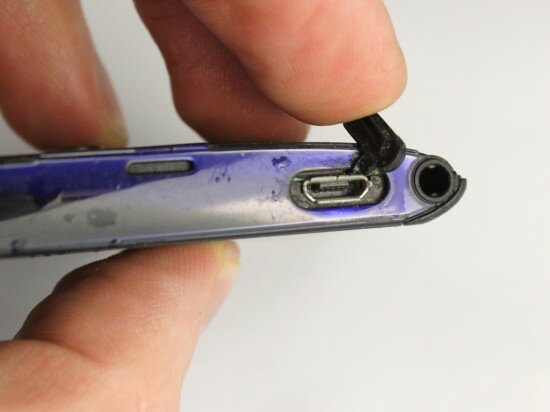
Pic. 25. Water in the USB port
If the phone wasn’t broken, the grade would be 30 (with 30 being the highest possible grade).
But the grade is 0 (with 30 being the highest possible grade)
3.8 Immersion in beer
In this test, we dunked the gadget under beer for 10 seconds (video 22). The results were similar to what we saw in the water tests. But the USB port didn’t get so wet as in the previous test of this review.
Next, we washed and dried the phone. Usually, we dry cell phones for an hour but this time, we had to dry the Vivaz much longer. After this, we found out that the quality of the tone from the loudspeaker became worse. The speaker started to produce a hoarse sound.
Video 22. Immersion in beer for 10 seconds
If the phone wasn’t broken, the grade would be 6 (with 9 being the highest possible grade).
But the grade is 0 (with 9 being the highest possible grade)
3.9 Dust test
In the last stage of this test, we vibrated the tray containing dust and the Sony Ericsson Vivaz for 10 min.
As a result, a lot of dust penetrated under the battery cover (Pic. 26). The USB port was full of dirt (Pic. 27). The spot on the display became larger (Pic. 28). But the performance of the keys was fine. The sound quality worsened considerably. We had to strain our ears in order to understand the person on the line.
It was easy to clean the connectors and the battery slot. But the loudspeaker and the display were damaged so much that we had to replace them.

Pic. 26. Dust in the battery slot
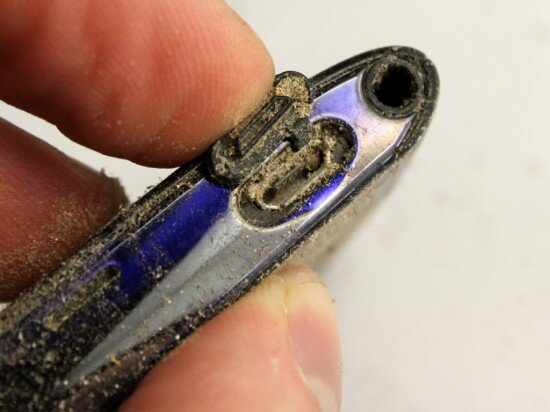
Pic. 27. Dirt in the USB port
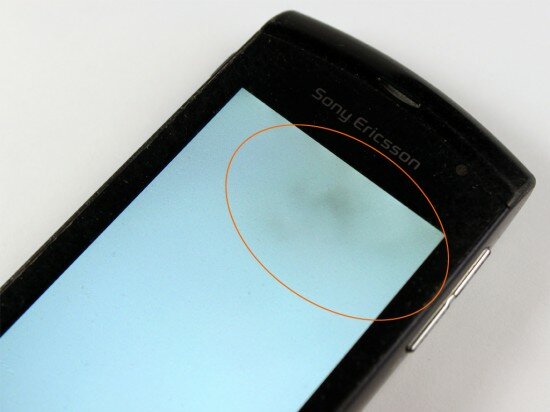
Pic. 28. The spot of dirt on the display
If the phone wasn’t broken, the grade would be 8 (with 12 being the highest possible grade).
But the grade is 0 (with 12 being the highest possible grade)
3.10 The keyboard
At first look, the keys of the Sony Ericsson Vivaz, doesn’t seem rugged. And we didn’t expect fine results from them. The large gaps between the keys and the front panel is one of the main disadvantages of the keypad. By the way, the keys have a low stroke. However, the keypad showed fine results. The keys survived the heat, cold, moist and dust. Only the volume rocker didn’t look so attractive as before the stress tests. But it stayed functional.
As a result of the drop tests, the keys started to malfunction. But it wasn’t the fault of the keys, it was the fault of the circuit board.
If the phone wasn’t broken, the grade would be 15 (with 15 being the highest possible grade).
But the grade is 0 (with 15 being the highest possible grade)
3.11 Signal strength test
In the last stage of this test, we decreased the size of the hole in the shielded box to 15 x 15 mm (0,59 x 0,59 inches). The result was the same as in the previous test: the signal indicator displayed only 2 bars from the maximum possible signal strength of 5. However, the phone successfully received all of the 10 incoming calls.
The grade is 15 (with 15 being the highest possible grade)
3.12 Short circuit and overcharge
At first, we wanted to know what would happen to the battery charger if we made a short circuit of the power supply terminals with the help of the forceps for 1 second (video 23). As a result, the battery charger started beeping. This often happens if you plug a cell phone with a very low battery into a charger. Evidently, this is rather a peculiarity of this model than its drawback.
Video 23. Short circuit of the battery charger
In order to check the quality of the battery protection, we also made a short circuit of the power supply terminals (+ and -) (video 24). After the test, the Vivaz performed successfully with this battery inside it.
Video 24. Short circuit of the battery
Next, we found out the minimal charging voltage and how the Sony Ericsson Vivaz can withstand the increase in charging voltage. Actually, we plugged the cell phone and the charger into the PSU and started changing the charging voltage (video 25).
The charging stopped when the voltage was extremely high and extremely low. However, the power consumption stayed the same – this is the fault of the manufacturers. We can only infer that the Vivaz showed an appropriate reaction to the change in charging voltage
Video 25. Change in charging voltage
Finally, we plugged the PSU in the phone instead of the battery and started to increase the energy supply until we reached 7 V (video 26).
The circuit board stayed safe. The power consumption didn’t exceed 300 mA. This is a good result. However, the Vivaz switched itself off when we decreased the energy supply to 3.4 V. This amount of voltage is enough for a cell phone to stay functional. This is one more strange thing that we witnessed during the stress tests.
Video 26. Increase/decrease in energy supply
If the phone wasn’t broken, the grades would be the following (with 15 being the highest possible grade):
For the ability of the battery charger to withstand short circuits – 15
For the ability of the battery to withstand short circuits – 15
For the ability of the phone to withstand increase/decrease in charging voltage – 15
For the ability of the phone to withstand increase/decrease in energy supply – 15
However, in this test, the Sony Ericsson Vivaz showed the following results (with 15 being the highest possible grade):
Ability of the battery charger to withstand short circuits – 0
Ability of the battery to withstand short circuits – 0
Ability of the phone to withstand increase/decrease in charging voltage – 0
Ability of the phone to withstand increase/decrease in energy supply – 0
3.13 Disassembling
After all the stress tests, we disassembled the Sony Ericsson Vivaz (Pic. 29).
In general, the build quality is fine. The circuit board has a very compact design. It’s small, compounded, shielded and has very few unnecessary spaces and details (Pic. 30, 31). The manufacturers didn’t solder any cords to the circuit board. All the elements are connected by the loops. There is a steel frame inside the body of the Vivaz. It makes the phone rigid.
However, we found some disadvantages: it’s really difficult to remove the display. The display was damaged in one of our stress tests but we decided not replace it ourselves.

Pic. 29. The Sony Ericsson Vivaz disassembled
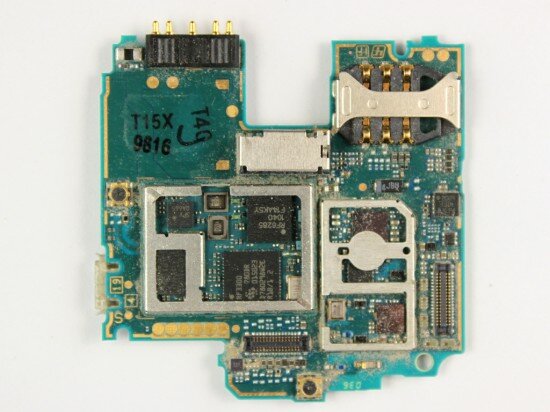
Pic. 30. The circuit board of the Sony Ericsson Vivaz
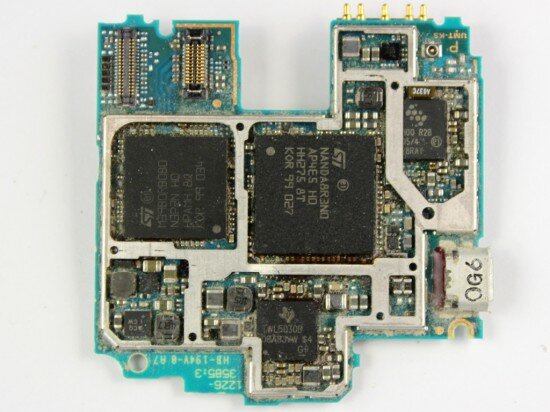
Pic. 31. The other side of the circuit board
The grade is 15 (with 15 being the highest possible grade)
After the 3rd stage of the stress tests, the Sony Ericsson Vivaz got 45 points (with 351 being the highest possible grade)
Conclusion:
It’s a pity that the Sony Ericsson Vivaz started to malfunction after the drop tests. This gadget had a real chance to get on top or, perhaps, in the middle of our rating.
Taking into consideration the price of the phone and the plastic material with glossy effect, the body of the Vivaz is robust. The touchscreen is not durable, though. We are really disappointed with it. The gadget showed good results in the freeze and the heat tests: the keys, the display and the battery performed fine. The build quality of the circuit board is also good. But don’t forget that the main reason of the malfunction was the problem with the circuit board.
The handset survived the immersions in water and in beer. But we had to dry it for a long period of time after these tests in order to make it functional. The phone is neither water nor dust resistant. We recommend you not use this handset in dirty environments. Otherwise, black spots may appear on the display. At last, some words about the drops, bumps and knocks. Try not to drop this phone at all if you don’t want it to become a data storage device that will always malfunction.
Here’s how the Sony Ericsson Vivaz looks like after all the tests (Pic. 32, 33, video 27).
Video 27. Here’s how the phone looks like after all the tests

Pic. 32. Here's how the front panel of the Sony Ericsson Vivaz looks like after all the tests

Pic. 33. Here's how the back panel of the Sony Ericsson Vivaz looks like after all the tests

 Russian version
Russian version
Comments (2)
wao wonderfull information. bundle of thanx bcz me using Sony Ericsson Vivaz and that is a Tweak
do u have a stress test for samsung galaxy s i9000
thankx